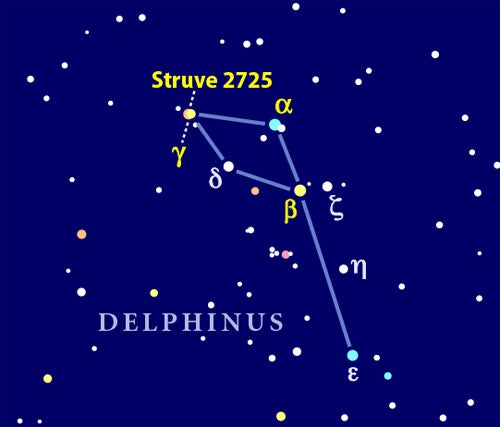Whenever someone asks me this question, invariably, I think of Orion. Big, bright, and brash, the mighty Hunter dominates the sky as no other constellation does. I’m partial to Scorpius, also, because of the striking resemblance it bears to its namesake, the scorpion. Cassiopeia and Sagittarius also rank high on my list, each being a rich hunting ground for deep-sky treasures. But of all the 88 recognized constellations, the one dearest to my heart is the humble little dolphin, Delphinus.
To fully appreciate this jewel of a constellation, you’ll need to view it in a relatively dark sky — no Full Moon or nearby city lights. FYI: Full Moons occur August 19 and September 17.
Once you’ve found Delphinus, turn your telescope toward Gamma (γ) Delphini — the Dolphin’s snout. It’s one of the prettiest double stars in the night sky. Gamma’s magnitude 4.5 and 5.5 component stars are separated by 10 arcseconds (“), so virtually any backyard telescope with a magnification of 50x shows them nicely. As you view this duo, try to detect a color difference. To me, the primary (the brighter component) seems a bit yellowish, while its partner appears bluish. What do you see?
Increase the magnification to 100x, and look carefully at the two 7th-magnitude stars that lie near Gamma. If you notice one of them has a tiny companion, you’ve “discovered” Struve 2725 — one of more than 3,000 double stars German/Russian astronomer Friedrich Struve observed and cataloged between 1825 and 1837.
Gamma Delphini appears in his catalog as Struve 2727. Relatively faint (magnitudes 7.6 and 8.4) and close (6″), Struve 2725 can be resolved in scopes with apertures as small as 60mm.
Two months from now, I’ll discuss how to use color filters to optimize your small-scope views of Mars. During the “great opposition” of 2003, I observed Mars nightly with a 4-inch Dobsonian-mounted reflector and an assortment of color filters. The two I found most useful were: #23A (light red), which improved the visibility of dark regions on the planet’s surface; and #80A (blue), which highlighted light areas — particularly the polar cap.
A typical color filter costs $15–$20 and screws into most standard eyepieces. If you don’t have color filters and plan to do some serious Mars-gazing, order some now (Mars reaches opposition November 7). Purchase from a reliable source, like the companies that advertise in this magazine.
An alternative, money-saving idea is to make your own color filters. GAM Products, Inc., offers deep-dyed polyester color filters for theatrical use, some of which are optically similar to standard astronomical filters. I’ll tell you more about making filters in the November issue. For now, order a GamColor swatch book for $3.50. Even if you own a set of color filters already, consider making an inexpensive backup set. Order by phone at 323.935.4975. Get ready. Mars will be here before you know it!
Next month: tips on how to use those cosmic road maps — star finders, planispheres, and star atlases. Clear skies.











